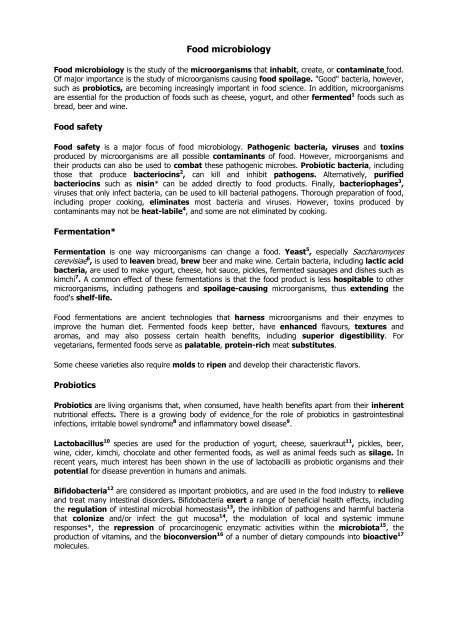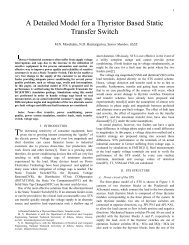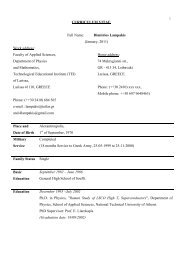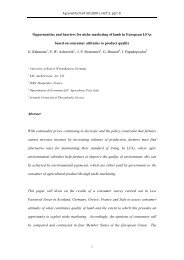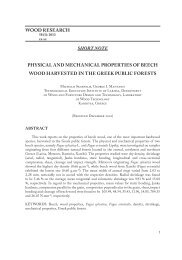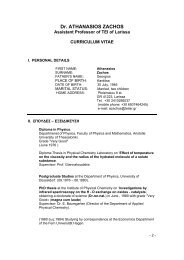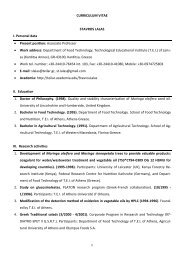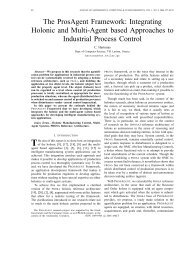Food microbiology
Food microbiology
Food microbiology
Create successful ePaper yourself
Turn your PDF publications into a flip-book with our unique Google optimized e-Paper software.
<strong>Food</strong> <strong>microbiology</strong><br />
<strong>Food</strong> <strong>microbiology</strong> is the study of the microorganisms that inhabit, create, or contaminate food.<br />
Of major importance is the study of microorganisms causing food spoilage. "Good" bacteria, however,<br />
such as probiotics, are becoming increasingly important in food science. In addition, microorganisms<br />
are essential for the production of foods such as cheese, yogurt, and other fermented 1 foods such as<br />
bread, beer and wine.<br />
<strong>Food</strong> safety<br />
<strong>Food</strong> safety is a major focus of food <strong>microbiology</strong>. Pathogenic bacteria, viruses and toxins<br />
produced by microorganisms are all possible contaminants of food. However, microorganisms and<br />
their products can also be used to combat these pathogenic microbes. Probiotic bacteria, including<br />
those that produce bacteriocins 2 , can kill and inhibit pathogens. Alternatively, purified<br />
bacteriocins such as nisin* can be added directly to food products. Finally, bacteriophages 3 ,<br />
viruses that only infect bacteria, can be used to kill bacterial pathogens. Thorough preparation of food,<br />
including proper cooking, eliminates most bacteria and viruses. However, toxins produced by<br />
contaminants may not be heat-labile 4 , and some are not eliminated by cooking.<br />
Fermentation*<br />
Fermentation is one way microorganisms can change a food. Yeast 5 , especially Saccharomyces<br />
cerevisiae 6 , is used to leaven bread, brew beer and make wine. Certain bacteria, including lactic acid<br />
bacteria, are used to make yogurt, cheese, hot sauce, pickles, fermented sausages and dishes such as<br />
kimchi 7 . A common effect of these fermentations is that the food product is less hospitable to other<br />
microorganisms, including pathogens and spoilage-causing microorganisms, thus extending the<br />
food's shelf-life.<br />
<strong>Food</strong> fermentations are ancient technologies that harness microorganisms and their enzymes to<br />
improve the human diet. Fermented foods keep better, have enhanced flavours, textures and<br />
aromas, and may also possess certain health benefits, including superior digestibility. For<br />
vegetarians, fermented foods serve as palatable, protein-rich meat substitutes.<br />
Some cheese varieties also require molds to ripen and develop their characteristic flavors.<br />
Probiotics<br />
Probiotics are living organisms that, when consumed, have health benefits apart from their inherent<br />
nutritional effects. There is a growing body of evidence for the role of probiotics in gastrointestinal<br />
infections, irritable bowel syndrome 8 and inflammatory bowel disease 9 .<br />
Lactobacillus 10 species are used for the production of yogurt, cheese, sauerkraut 11 , pickles, beer,<br />
wine, cider, kimchi, chocolate and other fermented foods, as well as animal feeds such as silage. In<br />
recent years, much interest has been shown in the use of lactobacilli as probiotic organisms and their<br />
potential for disease prevention in humans and animals.<br />
Bifidobacteria 12 are considered as important probiotics, and are used in the food industry to relieve<br />
and treat many intestinal disorders. Bifidobacteria exert a range of beneficial health effects, including<br />
the regulation of intestinal microbial homeostasis 13 , the inhibition of pathogens and harmful bacteria<br />
that colonize and/or infect the gut mucosa 14 , the modulation of local and systemic immune<br />
responses*, the repression of procarcinogenic enzymatic activities within the microbiota 15 , the<br />
production of vitamins, and the bioconversion 16 of a number of dietary compounds into bioactive 17<br />
molecules.
Microbial biopolymers<br />
A variety of biopolymers 18 , such as polysaccharides, polyesters and polyamides, are naturally<br />
produced by microorganisms. Several microbially-produced polymers are used in the food industry.<br />
Xanthan<br />
Plant-pathogenic bacteria of the genus Xanthomonas are able to produce the acidic<br />
exopolysaccharide xanthan gum 19 . Because of its physical properties, it is widely used as a<br />
viscosifer, thickener, emulsifier or stabilizer in the food industry.<br />
Alginate<br />
Alginate is the main representative of a family of polysaccharides. Alginates can be used as<br />
thickening agents. Although listed here under the category 'Microbial polysaccharides', commercial<br />
alginates are currently only produced by extraction from brown seaweeds such as Laminaria<br />
hyperborea or L. japonica.<br />
Cellulose<br />
Cellulose is a simple polysaccharide, in that it consists only of one type of sugar (glucose). Currently,<br />
the key genes involved in cellulose biosynthesis and regulation are known in a number of bacteria,<br />
but many details of the biochemistry of its biosynthesis are still not clear. In spite of the enormous<br />
abundance of cellulose in plants, bacterial celluloses are being investigated for industrial<br />
exploitations.<br />
Poly-γ-glutamic acid<br />
Poly-γ-glutamic acid (γ-PGA) is produced by various strains 20<br />
applications as a thickener in the food industry.<br />
of Bacillus. It has potential<br />
Levan<br />
Levan, a homopolysaccharide, has great potential as a functional biopolymer in foods, feeds,<br />
cosmetics, and the pharmaceutical and chemical industries. Levan can be used as food or a feed<br />
additive with prebiotic and hypocholesterolemic 21 effects.<br />
Exopolysaccharides<br />
Microorganisms synthesize a wide spectrum of multifunctional polysaccharides, including<br />
intracellular polysaccharides, structural polysaccharides and extracellular polysaccharides or<br />
exopolysaccharides (EPSs). EPSs generally consist of monosaccharides and some noncarbohydrate<br />
substituents (such as acetate 22 , pyruvate 23 , succinate 24 , and phosphate 25 ). Owing to the wide<br />
diversity in composition, they have found multifarious applications in various food and pharmaceutical<br />
industries.<br />
<strong>Food</strong>borne pathogens<br />
<strong>Food</strong>borne pathogens are the leading causes of illness and death in less developed countries, killing<br />
approximately 1.8 million people annually. In developed countries, foodborne pathogens are<br />
responsible for millions of cases of infectious gastrointestinal diseases each year, costing billions of<br />
dollars in medical care and lost productivity. New foodborne pathogens and foodborne diseases are<br />
likely to emerge, driven by factors such as pathogen evolution, changes in agricultural and food<br />
manufacturing practices, and changes to the human host status. There are growing concerns that
terrorists could use pathogens to contaminate food and water supplies in attempts to incapacitate<br />
thousands of people and disrupt economic growth.<br />
Enteric viruses<br />
<strong>Food</strong> and waterborne viruses contribute to a substantial number of illnesses throughout the world.<br />
Among those most commonly known are hepatitis A virus, rotavirus 26 , astrovirus 27 , enteric<br />
adenovirus 28 , hepatitis E virus, and the human caliciviruses consisting of the noroviruses 29 and the<br />
Sapporo viruses 30 . This diverse group is transmitted by the fecal-oral route 31 , often by ingestion of<br />
contaminated water and food.<br />
Protozoan parasites<br />
Protozoan parasites associated with food and water can cause illness in humans. Although parasites<br />
are more commonly found in developing countries, developed countries have also experienced several<br />
foodborne outbreaks. Contaminants may be inadvertently introduced to the foods by inadequate<br />
handling practices, either on the farm or during processing of foods. Protozoan parasites can be<br />
found worldwide, either infecting wild animals or in water and contaminating crops grown for human<br />
consumption. The disease can be much more severe and prolonged in immunocompromissed 32<br />
individuals.<br />
Mycotoxins<br />
Molds produce mycotoxins, which are secondary metabolites 33 that can cause acute or chronic<br />
diseases in humans when ingested from contaminated foods. Potential diseases include cancers and<br />
tumors in different organs (heart, liver, kidney, nerves), gastrointestinal disturbances, alteration of the<br />
immune system, and reproductive problems Mycotoxins occur mainly in cereal grains (barley, maize,<br />
rye, wheat), coffee, dairy products, fruits, nuts and spices. Control of mycotoxins in foods has focused<br />
on minimizing mycotoxin production in the field, during storage or destruction once produced.<br />
Aflatoxins are still recognized as the most important mycotoxins. The expression of aflatoxinrelated<br />
diseases is influenced by factors such as age, nutrition, sex, species and the possibility of<br />
concurrent exposure to other toxins. The main target organ in mammals is the liver, so<br />
aflatoxicosis 34 is primarily a hepatic disease. Conditions increasing the likelihood of aflatoxicosis in<br />
humans include limited availability of food, environmental conditions that favor mold growth on<br />
foodstuffs, and lack of regulatory systems for aflatoxin monitoring and control.<br />
Yersinia enterocolitica<br />
Yersinia enterocolitica includes pathogens and environmental strains that are ubiquitous in<br />
terrestrial and fresh water ecosystems. Evidence from large outbreaks of yersiniosis 35 and from<br />
epidemiological studies of sporadic cases has shown that Y. enterocolitica is a foodborne pathogen.<br />
Pork is often implicated as the source of infection. The pig is the only animal consumed by man that<br />
regularly harbors pathogenic Y. enterocolitica. An important property of the bacterium is its ability to<br />
multiply at temperatures near 0°C, and therefore in many chilled foods.<br />
Vibrio<br />
Vibrio species are prevalent in estuarine and marine environments, and seven species can cause<br />
foodborne infections associated with seafood. Vibrio cholerae O1 and O139 serotypes 36 produce<br />
cholera toxin and are agents of cholera. However, fecal-oral route infections in the terrestrial<br />
environment are responsible for epidemic cholera.
Staphylococcus aureus<br />
Staphylococcus aureus is a common cause of bacterial foodborne disease worldwide. Symptoms<br />
include vomiting and diarrhea that occur shortly after ingestion of S. aureus toxin-contaminated food.<br />
The symptoms arise from ingestion of preformed enterotoxin, which accounts for the short incubation<br />
time.<br />
Campylobacter<br />
Campylobacter is one of the major causes of bacterial gastroenteritis worldwide. Campylobacter<br />
infection is primarily a foodborne illness, usually without complications; however, serious sequelae 37 ,<br />
such as Guillain-Barre Syndrome, occur in a small subset of infected patients.<br />
Listeria monocytogenes<br />
Listeria monocytogenes is Gram-positive 38 foodborne bacterial pathogen and the causative<br />
agent of human listeriosis. Listeria infections are acquired primarily through the consumption of<br />
contaminated foods, including soft cheese, raw milk, deli* salads, and ready-to-eat foods such as<br />
luncheon meats and frankfurters. Although L. monocytogenes infection is usually limited to individuals<br />
that are immunocompromised, the high mortality rate associated with human listeriosis makes it the<br />
leading cause of death among foodborne bacterial pathogens. As a result, tremendous effort has been<br />
made to develop methods for the isolation, detection and control of L. monocytogenes in foods.<br />
Salmonella<br />
Salmonella serotypes continue to be a prominent threat to food safety worldwide. Infections are<br />
commonly acquired by animal to human transmission though consumption of undercooked food<br />
products derived from livestock or domestic fowl. The second half of the 20th century saw the<br />
emergence of Salmonella serotypes that became associated with new food sources (i.e. chicken eggs)<br />
and the emergence of Salmonella serotypes with resistance against multiple antibiotics.<br />
Shigella<br />
Shigella species are members of the family Enterobacteriaceae and are Gram negative*,<br />
nonmotile rods 39 . Symptoms include mild to severe diarrhea with or without blood, fever, tenesmus 40<br />
and abdominal pain. Further complications of the disease may be seizures 41 , toxic megacolon 42 ,<br />
reactive arthritis 43 and hemolytic uremic syndrome 44 . Transmission of the pathogen is by the fecal-oral<br />
route, commonly through food and water. Shigella spp. are one of the leading causes of bacterial<br />
foodborne illnesses and can spread quickly within a population.<br />
Escherichia coli<br />
More information is available concerning Escherichia coli than any other organism, thus making E. coli<br />
the most thoroughly studied species in the microbial world. For many years, E. coli was considered a<br />
commensal of human and animal intestinal tracts with low virulence potential. It is now known that<br />
many strains of E. coli act as pathogens, inducing serious gastrointestinal diseases and even death in<br />
humans.<br />
Clostridium botulinum and Clostridium perfringens<br />
Clostridium botulinum produces extremely potent neurotoxins that result in the severe<br />
neuroparalytic disease, botulism. The enterotoxin produced by C. perfringens during sporulation 45 of<br />
vegetative cells in the host intestine results in debilitating acute diarrhea and abdominal pain. Sales of<br />
refrigerated, processed foods of extended durability including sous-vide 46 foods, chilled ready-to-eat<br />
meals, and cook-chill foods have increased over recent years. Anaerobic spore-formers 47 * have<br />
been identified as the primary microbiological concerns in these foods.
Bacillus cereus<br />
The Bacillus cereus is a normal soil inhabitant, and is frequently isolated from a variety of foods,<br />
including vegetables, dairy products and meat. It causes a vomiting or diarrhea illness that is becoming<br />
increasingly important in the industrialized world. Some patients may experience both types of illness<br />
simultaneously. The diarrheal type of illness is most prevalent in the western hemisphere, whereas<br />
the emetic type is most prevalent in Japan. Desserts, meat dishes, and dairy products are the foods<br />
most frequently associated with diarrheal illness, whereas rice and pasta are the most common<br />
vehicles of emetic illness.<br />
Glossary<br />
1 fermentation: Any enzymatic transformation of organic substrates, especially carbohydrates, generally accompanied by the<br />
evolution of gas. (biochemistry) Any of many anaerobic biochemical reactions in which an enzyme (or several enzymes produced<br />
by a microorganism) catalyses the conversion of one substance into another; especially the conversion (using yeast) of<br />
sugars to alcohol or acetic acid with the evolution of carbon dioxide<br />
2 bacteriocins: αντιβιοτικό<br />
3 bacteriophages: βακτηριοφάγος<br />
4 heat-labile: θερμοευαίσθητος<br />
5 Yeast : ζυμομύκητας<br />
6 Saccharomyces cerevisiae : is a species of yeast. It is perhaps the most useful yeast, having been instrumental to baking and<br />
brewing since ancient times<br />
7 kimchi : A Korean dish made of vegetables, such as cabbage or radishes, that are salted, seasoned, and stored in sealed<br />
containers to undergo lactic acid fermentation.<br />
8 irritable bowel syndrome :(IBS, or spastic colon) is a diagnosis of exclusion. It is a functional bowel disorder characterized<br />
by chronic abdominal pain, discomfort, bloating, and alteration of bowel habits in the absence of any detectable organic cause.<br />
9 inflammatory bowel disease: (IBD) is a group of inflammatory conditions of the colon and small intestine. The major types<br />
of IBD are Crohn's disease and ulcerative colitis<br />
10 Lactobacillus :γαλακτοβάκιλοι<br />
11 sauerkraut: a dish made by fermenting finely chopped cabbage (ξινολάχανο)<br />
12 Bifidobacteria: δισχιδοβακτήρια<br />
13 homeostasis: ομοιόσταση<br />
14 gut mucosa: μεμβράνη, βλεννογόνος των εντέρων<br />
15 microbiota: μικροχλωρίδα<br />
16 bioconversion:The conversion of biological material into usable products; but especially the conversion of biomass into biofuel<br />
(βιομετατροπή)<br />
17 bioactive :Having a biological effect (βιοδραστικός)<br />
18 biopolymers: βιοπολυμερή<br />
19 acidic exopolysaccharide xanthan gum: όξινο ξανθακικό πολυσακχαριδικό κόμμι<br />
20 strain: A particular breed or race of animal, microbe etc. γένος
21 hypocholesterolemic : υποχοληστερολαιμική<br />
22 acetate: οξεικό οξύ/ αιθανικό οξύ<br />
23 pyruvate: πυροσταφυλικό<br />
24 succinate: (organic chemistry) any salt or ester of succinic acid (ηλεκτρικό οξύ)<br />
25 phosphate: φωσφορικό άλας<br />
26 rotavirus: Any of a group of wheel-shaped viruses, of the genus Rotavirus, that causes gastroenteritis and diarrhea in children<br />
and animals. (ροταϊό)<br />
27 astrovirus: (virology) Any member of the family Astroviridae of icosahedral viruses with a characteristic starlike surface<br />
structure<br />
28 enteric adenovirus : εντερικός αδενοϊός<br />
29 noroviruses: A genus of RNA viruses of the Caliciviridae family which causes gastroenteritis.<br />
30 Sapporo viruses: A genus of the family CALICIVIRIDAE associated with worldwide sporadic outbreaks of gastroenteritis in<br />
humans.<br />
31 fecal-oral route: through the feces and through the mouth<br />
32<br />
immunocompromissed : Having an immune system that has been impaired by disease or treatment.(ανοσοκατεσταλμένος)<br />
33 secondary metabolites : are organic compounds that are not directly involved in the normal growth, development, or<br />
reproduction of an organism.<br />
34 aflatoxicosis: a disease caused by the consumption of aflatoxins<br />
35 yersiniosis: is an uncommon infection caused by the consumption of undercooked meat products, unpasteurized milk, or<br />
water contaminated by the bacteria.<br />
36 serotypes: ορότυπος<br />
37 sequela (lae, plural): a disease or condition which is caused by an earlier disease or problem<br />
38 Gram-positive: Gram-positive bacteria retain the color of the crystal violet stain in the Gram stain. This is characteristic of<br />
bacteria that have a cell wall composed of a thick layer of a particular substance (called peptidologlycan). The Gram-positive<br />
bacteria include staphylococci ("staph"), streptococci ("strep"), pneumococci, and the bacterium responsible for diphtheria<br />
(Cornynebacterium diphtheriae) and anthrax (Bacillus anthracis). The Danish bacteriologist J.M.C. Gram (1853-1938) devised a<br />
method of staining bacteria using a dye called crystal (gentian) violet. Gram's method helps distinguish between different types of<br />
bacteria. The gram-staining characteristics of bacteria are denoted as positive or negative, depending upon whether the bacteria<br />
take up and retain the crystal violet stain or not.<br />
39 nonmotile rods<br />
40 tenesmus :The painful and often ineffectual straining to relieve the bowels (τεινεσμός)<br />
41 seizure: A sudden attack or convulsion, (e.g. an epileptic seizure).<br />
42 toxic megacolon : τοξικό μεγάκολο: οξεία κολίτιδα, η οποία συνοδεύεται από συστηματικές τοξικές εκδηλώσεις και<br />
απεικονιστικά ευρήματα τμηματικής ή καθολικής μη αποφρακτικής διάτασης του παχέος εντέρου και αποτελεί μια συνήθη,<br />
καταστροφική, δυνητικά θανατηφόρο επιπλοκή κολίτιδας.<br />
43 reactive arthritis : it can be the result of Salmonella infection or other gastrointestinal illnesses. The arthritis can be severe.<br />
44 hemolytic uremic syndrome : αιμολυτικό ουραιμικό σύνδρομο<br />
45 sporulation :T he process of a bacterium becoming a spore<br />
46 sous-vide : Describing a method of cooking, intended to maintain the integrity of ingredients, in which food is heated in<br />
airtight bags for an extended period of time at relatively low, but tightly controlled temperatures.
47 spore-formers: viruses producing spores<br />
*Nisin(biochemistry) a polycyclic peptide produced by fermentation with the bacterium Lactococcus lactis ; used as a<br />
preservative in processed cheese etc νισίνη<br />
Lactobacillus
READING COMPREHENSION<br />
a. Answer the following True or False statements. Provide the correct answer for the false<br />
ones.<br />
1. <strong>Food</strong> <strong>microbiology</strong> studies the microorganisms that contaminate food. T/F?<br />
2. <strong>Food</strong>borne pathogens are responsible for infectious gastrointestinal diseases in underdeveloped<br />
countries. T/F?<br />
3. Probiotics have nutritional effects only. T/F?<br />
4. <strong>Food</strong> and waterborne viruses are the cause of many serious enteric illnesses worldwide. T/F?<br />
5. Human Listeriosis is a leading cause of death among foodborne bacterial pathogens. T/F?<br />
6. Botulism is a severe cardiovascular disease caused by Clostridium botulinum neurotoxins. T/F?<br />
7. Bacillus cereus is never found in vegetables dairy products and meat. T/F?<br />
8. Shigella is not a leading cause of foodborne diseases. T/F?<br />
9. Escherichia coli can cause death in humans. T/F?<br />
10. <strong>Food</strong> fermentation is a modern technique. T/F?<br />
11. Many bacteria are used in food production. T/F?<br />
12. Most biopolymers are artificially produced. T/F?<br />
13. Environmental conditions lead to the appearance of aflatoxins. T/F?<br />
14. Staphylococcus aureus does not affect the immune system. T/F?<br />
15. Campylobacter is not a foodborne disease. T/F?<br />
B. Scan the text and answer the following questions.<br />
1. Which is a very important part of the food <strong>microbiology</strong> study?<br />
2. What is the main focus of the food <strong>microbiology</strong> study?<br />
3. What are possible contaminants of food?<br />
4. What bacteria can be used to fight other bacteria?<br />
5. What are the bacteriophages?<br />
6. What can eliminate most bacteria and viruses?<br />
7. Why are some contaminants not eliminated by cooking?<br />
8. What is the function of yeast?<br />
9. What is fermentation?<br />
10. What is the use of lactic acid bacteria?<br />
11. What is a result of most fermentations?<br />
12. What are the benefits of fermentation?<br />
13. What food involves “spoilage” by microorganisms to take its final form and taste?<br />
14. What are probiotics?<br />
15. Where are lactobacilli used?<br />
16. What may be an important future application of lactobacilli regarding health?<br />
17. What is the importance of bifidobacteria?
18. How is Xanthan used in the food industry?<br />
19. Which microorganism is widely used as a thickening agent?<br />
20. What is cellulose?<br />
21. Where can cellulose be found in large quantity?<br />
22. What are bacterial celluloses being tested for?<br />
23. Which acid has a possible application as a thickener in food industry?<br />
24. What are the effects of Levan as an additive?<br />
25. Are exopolysacharides useful in any way?<br />
26. What factors may help the development of new foodborne pathogens & food diseases?<br />
27. Which factors influence the appearance of aflatoxins?<br />
28. What is aflatoxicosis and conditions contribute to its appearance?<br />
29. How aresome very common enteric viruses transmitted?<br />
30. How may protozoan parasites be transmitted to foods?<br />
31. What are mycotoxins and what is their effect?<br />
32. Where do mycotoxins mainly occur?<br />
33. What kind of pathogen is Y. enterocollitica?<br />
34. What is an important characteristic of the bacterium Y. enterocollitica?<br />
35. Which is the most suspected source of Y. enterocollitica infection?<br />
36. With what kind of food is vibrio infection associated with?<br />
37. What is responsible for epidemic cholera?<br />
38. What is Staphylococcus aureus responsible for worldwide?<br />
39. What is a major cause of bacterial gastroenteritis worldwide?<br />
40. How is listeriosis is mainly acquired?<br />
41. How is salmonella aquired?<br />
42. How have salmonella serotypes developed since the second half of the 20 th century?<br />
43. What are the symptoms of shigellosis and how is it transmitted?<br />
44. What is a “special ability” of shigella spp?<br />
45. What kinds of foods are likely to carry Clostridium botulinum & C. perfrigens?<br />
46. Where Bacillus cereus is normally found?<br />
47. What kinds of foods are likely to carry B. cereus?
1<br />
FOOD MICROBIOLOGY –VOCABULARY<br />
Acute (adj): sharp; intense; very serious or dangerous: requiring serious attention or action<br />
Abundance (n): a large amount of something<br />
Agent (n): An active power or cause; something which has the power to produce an effect such as a<br />
physical, chemical, or medicinal agent; e.g., heat is a powerful agent.<br />
Bioactive: Having a biological effect βιοδραστικός<br />
Bioconversion (n): The conversion of biological material into usable products; but especially the<br />
conversion of biomass into biofuel βιολογική μετατροπή<br />
Brew(v): to go through the processes, of brewing or making beer; to prepare liquor<br />
Bowel: large intestine<br />
Colonize (v) : to create a colony in or on (a place) : to take control of (an area) and send people to<br />
live there; to move into and live in (a place) as a new type of plant or animal<br />
Combat (v): fight<br />
Commensal (n): (ecology) a form of symbiosis in which one organism gets a benefit while the other<br />
is unaffected<br />
Commercial (adj): relating to trade (εμπορικός)<br />
Concurrent (adj): Happening at the same time; simultaneous.<br />
Contaminate (v): To introduce impurities or foreign matter; to soil or defile. Μολύνω<br />
Contribute (v): to give something, that is or becomes part of a larger whole<br />
Eliminate (v): to completely destroy (something) so that it no longer exists<br />
Exploitation (n): The act of exploiting or utilizing. exploit(v): To usefully and effectively use what<br />
is available; to use for one’s own advantage.;<br />
Exposure (n)-expose(v): to cause (someone) to experience something or to be influenced or<br />
affected by something — + to<br />
Favor (v): to prefer; to be fond or something or someone (favour Br. English spelling)<br />
Ferment (v)- fermentation(n) : Any enzymatic transformation of organic substrates, especially<br />
carbohydrates, generally accompanied by the evolution of gas. (Ζύμωση)<br />
<strong>Food</strong>borne (adj): Transmitted through food.<br />
<strong>Food</strong>stuff (n): A substance that can be used or prepared for use as food.<br />
Fowl (n): A bird of the order Galliformes(ορνιθόμορφα) , including chickens, turkeys,<br />
pheasant(φασιανός), partridges (πέπδικες) and quail (ορτύκια).<br />
Emerge (v): to come out of a liquid; to come into view; become known; appear<br />
Emulsifier (n): A substance that helps to combine two liquids, esp. a water-based liquid and oil<br />
(γαλακτοματοποιητής)<br />
Enhance (v):To make better, more useful, more beautiful through modification.
2<br />
Exert (v): ασκώ (πίεση, επίδραση, δύναμη κλπ.)<br />
Extend (v): To cause to last for a longer period of time; to increase in extent<br />
Evolution (n): A gradual process of development, formation, or growth, especially, one leading to a<br />
more advanced or complex form; (biology) The change in the genetic composition of a population<br />
over successive generations.<br />
Host (n): (biology) cell or organism which harbors another organism<br />
Harbor (v): To provide a harbor or safe place for;(εγκωλπίζω- μεταφορική χρήση)<br />
Harness (v): to capture, control or put to use; restrict<br />
Handling (n)-handle(v): manage, treat, use<br />
Heat-labile (adj): θερμοευαίσθητα, θερμοασταθή<br />
Hospitable (adj): generous towards guests; receptive (μεταφορική χρήση)<br />
Inadequate (adj): insufficient; Deficient; unequal to the purpose<br />
Inadvertently (adv): by accident; without intention<br />
Infect (v): to bring into contact with a substance that can cause illness λοιμωξη, μολυνση<br />
Inflammatory (adj): φλεγμονώδεις<br />
Inhabit (v):<br />
Inherent (adj): naturally a part or consequence of something. συμφυτος<br />
Inhibit (v): to hinder; to restrain αναστελλω<br />
Immune (adj): Unable to catch a certain disease.<br />
Implicate (v): To connect or involve in an unfavorable or criminal way with something.<br />
Incubation (n): (pathology) The development of a disease from its causes, or its period of<br />
incubation.<br />
Irritable (adj): ευερέθιστος<br />
Isolation (n): (<strong>microbiology</strong>) the separation of a microorganism from others for identification<br />
Gene (n): (genetics) A unit of heredity; a segment of DNA or RNA<br />
Genus (n): rank in a taxonomic classification between family and species<br />
lactic acid: γαλάκτικο οξυ<br />
Leaven (v): To cause to rise by fermentation. Any agent used to make dough rise or to have a<br />
similar effect on baked goods./ μαγια προζυμι<br />
Livestock (n): Cattle, horses, and similar animals kept for domestic use especially on a farm.<br />
Luncheon (n): pork meat in various forms usually canned<br />
Mold (n): soft substance that grows on the surface of damp or rotting things
3<br />
Multifarious (adj): Having multiplicity; having great diversity or variety; of various kinds; made up<br />
of many differing parts;<br />
Multifunctional (adj): Having multiple functions<br />
Outbreak (n): a sudden increase<br />
Palatable Pleasing to the taste, tasty./εύγευστος<br />
Possess (v): to have; to have ownership of<br />
Potential (adj): existing in possibility, not in actuality; future; unrealized ability<br />
Prevalent (adj): Most frequent or common; Superior or dominant; Widespread or preferred.<br />
Prominent (adj): Immediately noticeable or standing out; distinguished above others<br />
Properties (n): the abstract qualities associated with an object; Attribute or characteristic of an<br />
object that is used to define its state, appearance, or value e.g., the properties of hydrogen<br />
Relieve (v): to reduce or remove (something, such as pain or an unpleasant feeling); relieve of: to<br />
take (something that is difficult or unpleasant) from (someone); remove pain<br />
Representative (adj): typical of a particular group of people or of a particular thing<br />
Repression (n): the act of not allowing a condition or state to be expressed (καταστολή)<br />
Ripen (v): To cause to mature;<br />
Seaweed (n): marine plants and algae<br />
Shelf-life (n): the length of time that food may be stored and still be good to eat<br />
Silage (n): Fermented green forage fodder stored in a silo<br />
Simultaneously (adv): actions or activities or events occurring at the same time<br />
Spectrum (n): range; Specifically, a range of colours representing light (electromagnetic radiation)<br />
of contiguous frequencies; hence electromagnetic spectrum, visible spectrum, ultraviolet spectrum,<br />
etc<br />
Stabilizer (n): substance added to something in order to stabilize it (σταθεροποιητής)<br />
Substantial (adj): large in size, quantity, or value ; most important; essential.<br />
Substitute: To use in place of something else, with the same function. A replacement or stand-in for<br />
something that achieves a similar result or purpose. (Αναπληρώνω αποκαθιστώ αντικαθιστώ)<br />
Substituent(n): (chemistry) Any atom, group, or radical substituted for another, or entering a<br />
molecule in place of some other part which is removed.<br />
Superior (adj):higher in rank or quality;<br />
Terrestrial (adj): living or growing on land; not aquatic<br />
Texture (n): The feel or shape of a surface or substance; the smoothness, roughness, softness, etc.<br />
of something.<br />
Thickener (n): Any substance added to something in order to thicken it (πυκνωτικό)
4<br />
Vehicle (n): a means of transportation; a medium through which something is transmitted or<br />
circulated; an agent<br />
Virulence (n): The ability of a microorganism to cause damage to its host; its toxicity<br />
Viscosifier (n) : a substance which is used to make a liquid thicker -viscous (adj)- of a liquid :<br />
thick or sticky : not flowing easily<br />
Ubiquitous (adj): be present everywhere
FOOD MICROBIOLOGY-VOCABULARY DEVELOPMENT-LAB. SESSION<br />
A. Skim the text and match the following descriptions with a suitable term<br />
1. A pathogen transmitted through food.<br />
2. Happening by accident or unintentionally<br />
3. A product which is produced in large quantities and is sold widely in the market<br />
4. To make a place or substance dirty or harmful by putting sthg such as chemicals or<br />
poison in it.<br />
5. The enzymatic transformation of organic substrates, especially of carbohydrates, which is<br />
usually accompanied by the evolution of gas.<br />
6. The soft substance that grows on the surface of things that rot<br />
7. A substance that helps to combine two liquids into a milkfish form<br />
8. The gradual process of development or growth, leading to a more advanced or complex<br />
form<br />
9. A cell or organism which “carries” another organism<br />
10. To bring sthg or somebody into contact with a substance that can cause illness<br />
11. To restrain sthg from happening.<br />
12. A substance which is used to make another substance thicker when added to it.<br />
13. The development of a disease from its causes in the body until it shows its physical signs<br />
14. A laboratory process which achieves the separation of a microorganism from others for<br />
identification<br />
15. Farm animals kept for domestic use<br />
16. A sudden increase or emergence of sthg<br />
17. Something which has future possibility or ability<br />
18. Something which is typical of a particular group of people or of a particular thing<br />
19. The particular qualities or characteristics of an element that define its state, appearance<br />
etc.<br />
20. The length of time that food may be stored and still be good to eat<br />
1
FOOD MICROBIOLOGY-VOCABULARY DEVELOPMENT-LAB. SESSION<br />
B. Complete the table with the missing word forms.<br />
Colonize<br />
prevalent<br />
thickener<br />
substitute<br />
expose<br />
exploitation<br />
contribute<br />
representative<br />
inhibit<br />
irritable<br />
fermented<br />
eliminate<br />
contaminating<br />
isolate<br />
incubation<br />
implicated<br />
stabilizer<br />
emerge<br />
inhabitant<br />
exert<br />
2
FOOD MICROBIOLOGY-VOCABULARY DEVELOPMENT-LAB. SESSION<br />
C. Prefixes<br />
Prefixes are added to the beginning of words to change a) the word as part of the speech e.g.,<br />
from noun to adjective b) the meaning of words; e.g, opposite, negative, c) to show degree,<br />
space, quantity etc.<br />
The following are some common prefixes of Greek, Latin and French origin<br />
• en-, em- derives a verb from a noun or adjective e.g.: enforce=make sthg larger<br />
• inter- (means between/among) e.g.: interact<br />
• re – ( means again) e.g.: reproduce<br />
• counter - (means against/ opposite to) e.g.: counteract<br />
• over- (means too much/in excess) e.g.: overweight<br />
• under –(means too little) e.g.: underweight<br />
• dis – (means the opposite) e.g.: disconnect<br />
• de – (means cause not to be) e.g.: dehydrate<br />
• im-, ir-, in-, (means not) e.g.: impure, incorrect, irresponsible<br />
• un- (means not) e.g.: unnecessary<br />
• super- (means above/more than) e.g.: supersaturated<br />
• sub- (means beneath, less than) e.g.: subunit<br />
• for(e)- (means ahead, future) e.g.: forward, forecast<br />
PACTICE<br />
Use the above prefixes to change the following words<br />
inhabited, essential, contaminated, infect, active, regular, digestible, possible, nourished,<br />
function, order, calculate, rate<br />
3


